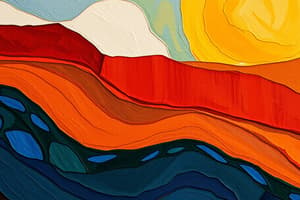Podcast
Questions and Answers
What are sedimentary rocks?
What are sedimentary rocks?
Made from an accumulation of various types of sediments.
What is sediment?
What is sediment?
Fragments that result from the breaking (weathering) of rocks, minerals, and organic matter.
Most sedimentary rock forms under water.
Most sedimentary rock forms under water.
True (A)
What is limestone primarily composed of?
What is limestone primarily composed of?
What is Rock Salt also known as?
What is Rock Salt also known as?
Sedimentary rock forms from these processes: __________, __________, __________, and __________.
Sedimentary rock forms from these processes: __________, __________, __________, and __________.
What are the three types of sedimentary rocks?
What are the three types of sedimentary rocks?
What characterizes clastic sedimentary rocks?
What characterizes clastic sedimentary rocks?
What defines chemical sedimentary rocks?
What defines chemical sedimentary rocks?
What constitutes organic sedimentary rocks?
What constitutes organic sedimentary rocks?
What is stratification in sedimentary rocks?
What is stratification in sedimentary rocks?
What are ripple marks?
What are ripple marks?
What are fossils?
What are fossils?
Flashcards are hidden until you start studying
Study Notes
Sedimentary Rocks Overview
- Composed of accumulated sediments from various sources.
Sediment
- Fragments resulting from the weathering of rocks, minerals, and organic matter.
- Examples include gravel, clay, silt, pebbles, sand, mud, shells, and dirt.
Formation of Sedimentary Rocks
- Most sedimentary rocks form underwater.
- Common examples include limestone and halite.
Limestone Characteristics
- Mainly composed of calcium carbonate.
- Forms both organically (from shells, corals, algae) and chemically (from precipitation in water).
- Widely used in producing cement, crushed stone, and for acid neutralization.
Rock Salt (Halite)
- A chemical sedimentary rock formed by the evaporation of saline water.
- Generally not found at Earth's surface, except in arid climates.
- Mined for chemical industry uses and as a winter road treatment; some processed for culinary seasoning.
Processes of Sedimentary Rock Formation
- Compaction: Sediments are pressured together, expelling water and air.
- Cementation: Dissolved minerals precipitate from water, gluing sediments together.
- Precipitation: Minerals clump and fall out of solution.
- Evaporation: Water evaporation leaves behind dissolved minerals.
Types of Sedimentary Rocks
- Three main categories: Clastic, Chemical, and Organic.
Clastic Sedimentary Rocks
- Composed of fragments from other weathered rocks.
- Classified by sediment size: coarse (pebbles), medium (sand), fine (clay or silt).
- Examples include sandstone (sand), shale (silt/clay), conglomerate (rounded pebbles), and breccia.
Chemical Sedimentary Rocks
- Form from minerals once dissolved in water.
- Can result from precipitation or evaporation of water.
- Classified by mineral composition, with examples like chemical limestone (CaCO3), gypsum (CaSO4), and halite (NaCl).
Organic Sedimentary Rocks
- Created from remains or traces of organisms.
- Examples include coal (plant material), chalk (animal skeletons), and organic limestone (shells primarily made of CaCO3).
Features of Sedimentary Rocks
- Stratification: Layering of sediments reflecting changes in sediment type, exemplified in formations like the Grand Canyon.
Ripple Marks
- Formed by wind or water action on sand, evident in sandstone.
Fossils
- Remains or traces of ancient plants and animals commonly found in sedimentary rocks.
Studying That Suits You
Use AI to generate personalized quizzes and flashcards to suit your learning preferences.




